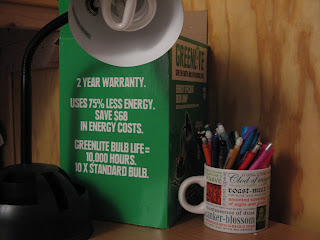
Week 15
Advocacy Project: This was the last assignment in this series! We had to create a learning activity related to our topic for our group members to complete. Looking back, mine was pretty boring compared to some of the fun games other people found. Sorry group! Thanks for bearing with me. :) Also, I'll admit that I was slightly afraid of the advocacy project when I looked ahead at the course calendar earlier this semester, but it really wasn't so bad and I definitely gained some useful knowledge and skills.
Tuesday: Sue Whitney came and spent the whole class period with us! She even gave us each a copy of her book Junk Beautiful Outdoor Edition. THANK YOU!
This was a very fun day of class. In my opinion, junking is very cool and it's too bad that many people these days have lost the art of reusing things - we have developed an obsession with getting everything new. I guess I never really considered myself to be a "junker" , but maybe I am in my own way. I love to reuse items, but I go at it from a more practical point of view, not necessarily in an artsy creative way. If I need something, I'll try to create it out of something else that's around, or just scavenge for it. For example, when I moved into my house last summer, I owned no furniture. Within days, I found an old desk someone had set out on the curb. It was in great condition so I hauled it back to my house and it's served me well this entire school year! Also, I created a dresser from the grocery store fruit boxes that I had used to pack my things in when I moved. My mom and my grandma have definitely served as great role models because they are both very thrifty and creative! I really liked what Sue said about making functional pieces, because in my opinion it's unnecessary to just make a lot of home decor. Previously, I tended to associate junkers with houses full of clutter, but now I think I am over that stereotype!
We also had Subway this day! Like I said, it was already a fun day, but getting free food in class never hurts. :) YUM!
Thursday: Last day of class! Prizes were given out for our mini junking contest. Congratulations to the winners! There were some excellent entries.
Then we went outside and talked about what we've learned in the class. I've learned so much, I don't even know where to start! I think the main thing I will take away from this class is my increased awareness of environmental issues and how this affects all my daily decisions, no matter how big or small they might seem.
Week 16
Eye Opener: Our last eye opener assignment was to complete all the online learning activities created by our group members. Nice work, Group 5! I'll miss blogging with you guys!
Well, I guess this will be my last real post. I honestly can't believe the semester is over, it just seemed to fly by. I will miss this class - it truly was one that I looked forward to going to. And I appreciated learning things that are so obviously intertwined with my everyday life. I know I am learning useful skills in my other classes as well, but most of it seems like things I will use "some day" when I have a "real job." Much of the information from this class applies to my life right now!
I'm glad I got the hang of blogging, and it did start to get addictive. Hopefully my new tech skills will come in handy in the near future! Also, it was great to meet a lot more people in my major. Actually, it was a little overwhelming at first because everyone seemed to know each other very well. I didn't know too many people because the other health classes I was in this semester only had a handful of people in them so this was a great opportunity to get to know you guys!
Thanks for making this such a great semester, everyone! Have an awesome summer, and I hope to see many of you next year!
(Picture taken by me: sunset on Lake Superior.)

































